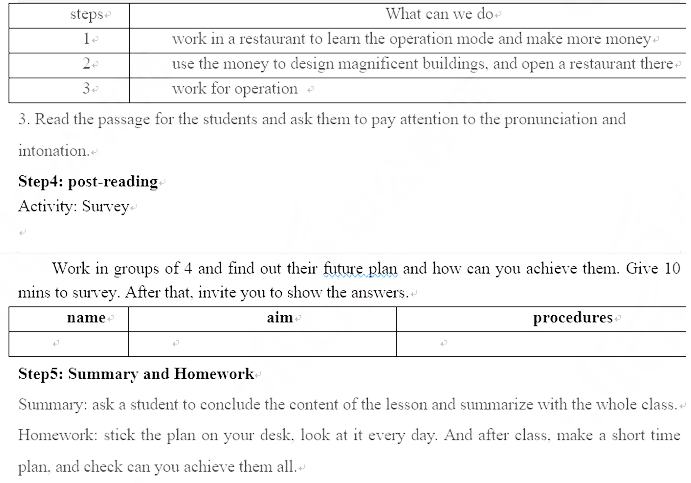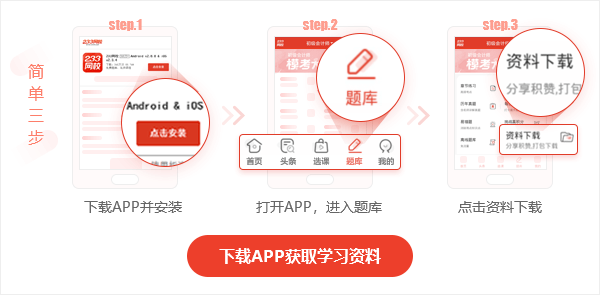高中英语 词汇
一、考题回顾
试讲题目
1.题目:词汇教学试讲
2.内容:
Taxis are on the streets 24 hours a day. Simply raise your hand, and a taxi appears in no time. They are usually red, and they display the price per kilometer on the window. You should check the cab has a business permit, and make sure you ask for a receipt. Public transport provides a cheap way to get around in Beijing. There are 20,000 buses and trolleybuses uses in Beijing, but they can get very crowded. It’s a good ideas to avoid public transport during the rush hour (6:30 a.m-8:00 a.m and 5:00 p.m-6:30 p.m). Fares are cheap, starting at 1 yuan. Air-conditioned buses cost more. Buses numbered 1 to 100 are limited to travel within the city center. Higher numbers have destination in the suburbs.
3.基本要求:
(1)朗读所给段落
(2)配合教学内容适当板书
(3)针对所给材料的画线部分,设计词组使用的教学活动。
(4)用英文试讲
(5)试讲时间:10分钟
答辩题目
1.Please introduce your teaching mode.
2.What’s your key and difficult points?
二、考题解析
【教案】
Teaching aims:
Knowledge aims:
(1) Students can master the meaning and usage of “in no time”, “ask for”, “get around” and “limit to”.
(2) After this lesson, students can know the traffic conditions about Beijing.
Ability aim:
After this lesson, students can use these phrases express their opinions.
Emotional aim:
Students are able to get the confidence of learning English.
Students are willing to use public transport to release the traffic jam after this lesson.
Key and difficult point:
Key Point: master the meaning and usage of the new phrases.
Difficult Point: use the new vocabulary to express themselves.
Teaching procedures:
Step 1: Warming-up
1. Greetings.
2. Free talk.
Tell students I suffered the traffic jam this morning. Ask students to think what they know about Beijing’s traffic situation and invite some students to share.
3. Tell student we will learn more about the traffic conditions in Beijing.
Step 2: Presentation
1. Ask students to read the passage and try to circle some phrases they don’t understand. Then write down these phrases, “in no time”, “ask for”, “get around” and “limit to” on blackboard.
2. Teach students the new phrases one by one through situation teaching method. Put these new words in a easier situation “we are going to visit a museum”. in this situation, explain the meaning and usage of the four phrases.
Step 3: Practice
1.Fill in the blanks: Ask students to fill in the blanks using the new phrase.
①You can simply raise your hand and a taxi appears .
②I want to in Beijing.
③You should a receipt from the taxi driver.
3. Create sentences: Ask students to combine the sentences and use the new phrase.
①We need ask for the permission before leaving the class.
②The best way to relax ourselves is to get around without and purposes.
Step4: Production
1.Discussion
Give students 5 minutes to have a discussion about the traffic situation around their home in a group of four.
2.Then invite some students to share their results in front of the whole class and give them some specific evaluations.
Step5: Summary and Homework
Summary: ask a student to conclude the content of the lesson and summarize with the whole class.
Homework: ask students to think how to solve the traffic problems and write down.
Blackboard design:略
【答辩题目解析】
1.Please introduce your teaching mode.
【参考答案】
Since it is a vocabulary, so I use PPP mode: presentation, practice and production.
Firstly, presentation. I let my students read the passage by themselves and ask them to circle the words that are hard for them. then I invite a student to share his or her answer and write them on blackboard. Then I explain the meaning and usage of these words. to make my students master the words better. Then I let them to fill in the blanks and create new sentences. The final part is production. to help them use the words better. I set a discussion about traffic around their home.
2.What’s your key and difficult points?
【参考答案】
The key point is that students will master the meaning and usage of the new phrases. The difficult point is how use the new vocabulary to express their ideas.
高中英语 听力
一、考题回顾
试讲题目1.题目:听力教学试讲
2.内容:
The word “tsunami” often arouses panic and fear. Yet there is no need to be so anxious if you know what to do. As long as you have ten minutes warning, you will survive no matter how powerful the actual tsunami may be. Unfortunately, many people are unconscious of the risk they may be facing. As soon as you hear the warning, put on your shoes and walk inland as quickly as you can. Do not fear, tremble or remain tied to the spot at the thought of those high waves. Ten minutes running away from the sea is all you need to save yourself from danger. Remember this and you will be absolutely safe.
3.基本要求:
(1) 朗读所给段落
(2) 配合教学内容适当板书
(3) 针对该段落的内容,设计相应的听力理解教学活动。
(4) 用英文试讲
(5) 试讲时间:10分钟。
答辩题目1.How to evaluate students’ performance?
2. Please the person that influence you most.
二、考题解析
【教案】
Teaching aims:
Knowledge aims:
(1) Students are able to understand the content of the passage.
(2) Students can master some basic reading strategies.
Ability aim:
Students can use different basic reading strategies like analyzing, grasping details correctly in their reading process.
Emotional aim:
Students will be more willing to get involved in class activities and boost their interest in learning English.
Students may enhance their awareness towards some natural disasters.
Key and difficult point:
Key Point: understand the main content of the passage.
Difficult Point: improve students’ learning interest and boost their confidence of speaking in public.
Teaching procedures:
Step 1: Warming-up
1. Greeting.
2. Watch a video:
Show students a short video clip about earthquake and ask students to answer some questions:
(1). What happened in the video?
(2). Are you afraid of such kind of disaster?
Invite two students to share their answers and lead in the topic- disaster.
Step 2: Pre-listening
1.Brainstorming:
Ask students how many kinds of natural disasters they know, try to recall some words related to natural disasters. Write down some of their answers on the blackboard to and give evaluation to the students.
2.Prediction:
Ask students to make a prediction about what kind natural disaster may be mentioned in the passage.
Step 3: While-listening
A. Extensive listening:
1.Let students to listen to the passage for the first time. Ask students a question: What kind of disaster is mentioned in the passage? (This passage talks about the tsunami)
2.Then invite one student answer the question and give evaluation.
B. Intensive listening:
1.Ask students to listen to the passage for the second time and finish the exercise on the blackboard to have a better understand about the disaster:
1). If you have a ten minutes warning, you will not survive. (T/F)
2). What should you do after you hear the warning?
3). What shouldn’t we do at the thought of those high waves?
…
2.Then invite two students to answer these questions separately and give evaluation. Write down the right answers on the blackboard.
3. Read the passage for the students and ask them to pay attention to the pronunciation and intonation.
Step4: post-listening
1.Discussion:
Divide students into groups of 4 and lead them to have a discussion about what else should we to protect ourselves from tsunami. 5 minutes will be given and after that, choose some representatives to share their ideas.
2. Interview:
Ask students to work in pairs, one is the interviewee and the other is the interviewer. Then make an interview to imitate a reporter to interview a victim suffered from tsunami.
Step5: Summary and Homework
Summary: ask a student to conclude the content of the lesson and summarize with the whole class.
Homework: Surf on the Internet and find more natural disasters and make a poster about their findings.
Blackboard design:略
【答辩题目解析】
1.How to evaluate students’ performance?
【参考答案】
Students may make some mistakes during their process of learning, but as for how to correct their mistakes, it is an art. Students in this age like being praised by teachers and do not want to be blamed for their mistakes. So, as a teacher, we must know to evaluate students’ performance artfully. No matter what their answers are, we must give them positive evaluations to encourage them. For example, we can say to them “good job” “well done” “you are a good listener” “you can do better next time” and so on to respond to their performance. If we correct their mistakes directly, they may lose hear in learning. So, we teachers must praise them more, and they may get more interested in our English class.
2. Please the person that influence you most.
【参考答案】
When it comes to the person that influence me most, I would think of my English teacher in senior high school. She is the most helpful person that I have ever met. At that time, we are very naughty and do not know the importance of study. Though she was not responsible for the management of our class, but she would spend some of her spare time to tell us the importance of study. Our English is very poor also, she would try her best to teach us some good ways to memorize words and improve our listening, reading, speaking abilities and so on. Finally, the majority of us all passed the test for college entrance examination. And influenced by her, I choose English/ English education as my major. I am looking forward to being a teacher just like her.
高中英语 阅读
一、考题回顾
试讲题目1.题目:阅读教学试讲
2.内容:
Before long,my nephew and his friends graduated from their university. After that, they moved to New Orleans to start their new life. They were planning to open restaurant and bakeries, and design magnificent buildings. They told me they wound still play music, just like what they have done when they were in the university. They showed me their plans. Firstly, they would work in a restaurant to learn the operation mode and make more money. Secondly, they could use the money to design magnificent buildings, and open a restaurant there. Then, they would work for operation all day long.
3.基本要求:
(1) 朗读所给段落
(2) 配合教学内容适当板书
(3) 针对该段落的内容,设计相应的读后活动。
(4) 用英文试讲
(5) 试讲时间:10分钟。
答辩题目1.What is your motto?
2. What is your career plan?
二、考题解析
【教案】
Teaching aims:
Knowledge aims:
(1) Students are able to understand the content of the passage.
(2) Students will know how to use firstly, secondly and then.
Ability aim:
Students can improve their reading skills, especially global reading and detailed reading.
Students can predict what follows in the passage according to the topic.
Emotional aim:
Students will practice their logical thinking.
Students can make their own future plan.
Key and difficult point:
Key Point: 1. Catch the main idea of the passage.
2. Find out the way to express their plan.
Difficult Point: How to make their own future plan.
Teaching procedures:
Step 1: Warming-up
1.Greeting.
2.Sing a song.
Sing a English song-《Be what you wanna be》to light the atmosphere and recall some words about jobs.
3.Free talk.
Say to my students “How are you today? I am glad to see that all of you are feel good today. I feel happy, too. Because I achieve one of my life plan-----become a teacher! How about you? What do you want to be in the future? ”
Step 2: Pre-reading
1.Prediction:
Questions 1: if you want to be a teacher, what will you do?
Questions 2: if you want to operate a restaurant, what can you do?
Ask some students to share their answers, and tell them then we will check the answer from our passage today.
Step 3: While-reading
A. Extensive listening:
1.Let students to listen to the passage for the first time and find out the main idea of the passage: the plan of writer’s nephew about the operation of a restaurant.
2.Then invite one student answer the question and give evaluation.
B. Intensive listening:
1.Ask students to listen to the passage for the second time and fill in the chart on the blackboard.

Blackboard design:略
【答辩题目解析】
1.What is your motto?
【参考答案】
A motto is a sentence or a phrase1.can inspire us especially when we are faced with difficulties. Many of us have our mottoes, such as “Where there is a will, there is a way.” or “Nothing is difficult if you put your heart into it.”, and so on. My motto is “God helps those who help themselves” Sometimes I am lazy and don’t want to make efforts to work hard, but the moment I think of my motto I will get energetic again and devote myself to what I am doing. I write my motto where I can see it easily. Every time I fail in my exam and begin to lose heart, the sight of my motto inspires me with much confidence. My motto also makes me become an independent person. That is to say, I won’t rely on others easily.
2. What is your career plan?
【参考答案】
Just as the saying goes, everything should be planned before, so does being a teacher. If I had a chance to be a teacher this time. I would plan my future career from both short and long perspective. First, in short term, I would spend some time to get familiar with my students, my colleagues, my teaching content and so on, in other words, to get familiar with the person I am going to face and things I am going to do. While In the long term, I should learn hard and improve myself. I can learn from some experienced teachers, from books and from students. Try to be a teacher that can undertake the hard, tough teaching tasks, even be one that can get involved in the research and development of textbook. I hope you honorable judges can give me a chance.
声明:本文真题来源考生回忆及网络渠道搜集,仅供考生参考,如有侵权,请联系删除!
下载233网校APP,可下载教师资格证面试真题!
| 免费注册233网校会员,获取教师资格证面试资料包!点击注册>> |
小编推荐:教师资格证面试考试流程 面试考生须知
真题推荐:历年教师资格证面试真题>>>
通关秘籍:教师资格证面试如何快速通关?233网校讲师将面试情景还原,助你一举攻下“结构化面试+试讲+答辩”三大内容,实战通关!免费体验>>


